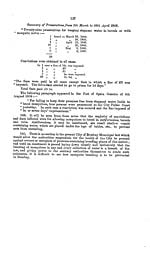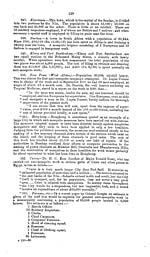Medicine - Disease > Report of an investigation into the causes of malaria in Bombay and the measures necessary for its control
(168) Page 128
Download files
Individual page:
Thumbnail gallery: Grid view | List view

128
CHAPTER IV.
THE COST OF MOSQUITO PREVENTION.
Section 1.
341. THE COST OF MOSQUITO PREVENTION IN OTHER PARTS
OF THE WORLD.-It is necessary to discuss the cost of mosquito prevention at
some length, in order to arrive at an idea of the expenditure demanded by efficient
work of this nature. Below are given certain figures relating to the staff
employed and the expenditure incurred in a number of towns in the tropics in
which anti-mosquito work has been undertaken.
342. Ismailia.-A town with a population of 8,000 people. No rainfall
and no rivers or streams. All mosquito-breeding places artificial, including the
irrigation channels and small marshes formed by leakage from the fresh water
canal. For anti-mosquito work a gang, consisting of a European inspector and
three men, was employed. They visited the houses and compounds in the town
and destroyed any mosquito larv they found with kerosine and crude petroleum.
In addition, some engineers and a number of workmen were employed in clear-
ing gardens of all pools, puddles and stagnant water generally. The cost of
the permanent work was Rs. 30,000. The annual cost of keeping the gardens
and irrigation channels free of mosquito larv is now Rs. 4,875 and the oiling
of the cess-pools and the general work of the mosquito brigade in the town is
Rs. 6,562-8-0 per annum, of which Rs. 3,312-8-0 is spent on oil and Rs. 3,250
on salaries, etc. The cost of this regular work is now about Rs. 1-3-0 per head
of the population per annum. In the early years the cost was Rs. 1-7-0 per
head of the population.
343. Port Said.-Port Said has about 50,000 inhabitants and covers only
a small area. It is practically surrounded by sea, being situated on a narrow
triangular spit of land bordered by the Mediterranean, the Suez Canal and the
shallow sea-water Lake of Menzalah. There are no rivers or streams and there
is no rainfall. Two gangs, one of five and one of four men, each under the
charge of a foreman, were engaged in anti-mosquito work. In 1907 41,120
gallons of oil were used and the cost of the work was about Rs. 18,380. In
1908 a large number of cellars, which used to become flooded with sewage, were
filled with sand; and as a result only 31,670 gallons of oil were used and the
total cost of the work (exclusive of the filling up of the cellars, which was done
by the house-owners and required 17,000 cart loads of sand) amounted to about
Rs. 16,000 or close upon 5 annas per head of the population of which the oil
used cost Rs. 11,500 and the labour about Rs. 4,500. The cost of the work
at Port Said is very much less than that at any other place.
344. Havana.-The City of Havana has a population of about 250,000
people crowded into a small area. The rainfall is heavy. In 1901 Gorgas
commenced anti-mosquito work there. The number of men employed in the
anti-stegomyia brigade was 75 and 150 men formed the anopheles brigade. The
latter worked chiefly in the outskirts of the City. The work is still being
continued. The City is now divided up into 63 districts each in charge of a
sanitary inspector.
345. Rio de Janeiro.-A City of large area with 800,000 inhabitants and
85,000 houses. The rainfall is heavy. Anti-mosquito work was commenced
in 1903. About 1,500 men were employed in destroying mosquito larv and
others on fumigation, etc. The author of "Comment on assainit un pays", a
pamphlet which describes the sanitary improvement effected at Rio de Janeiro,
states that the amount expended yearly on anti-mosquito work is not less than
3,000,000 francs or about 18,75,000 rupees, a sum equal to more than Rs. 2
per head of the population per annum.
346. New Orleans.-A large City with 325,000 inhabitants. Because of
Yellow Fever, anti-mosquito work was commenced in 1905. Boyce gives the
total number of men employed on the work as follows:-
910
Total number of men employed in inspecting oiling and screening
910
Special Fumigating Division
156
Special Investigating Division
105
Purveyor's Department
32
The total medical staff employed was fifty.
1,203
CHAPTER IV.
THE COST OF MOSQUITO PREVENTION.
Section 1.
341. THE COST OF MOSQUITO PREVENTION IN OTHER PARTS
OF THE WORLD.-It is necessary to discuss the cost of mosquito prevention at
some length, in order to arrive at an idea of the expenditure demanded by efficient
work of this nature. Below are given certain figures relating to the staff
employed and the expenditure incurred in a number of towns in the tropics in
which anti-mosquito work has been undertaken.
342. Ismailia.-A town with a population of 8,000 people. No rainfall
and no rivers or streams. All mosquito-breeding places artificial, including the
irrigation channels and small marshes formed by leakage from the fresh water
canal. For anti-mosquito work a gang, consisting of a European inspector and
three men, was employed. They visited the houses and compounds in the town
and destroyed any mosquito larv they found with kerosine and crude petroleum.
In addition, some engineers and a number of workmen were employed in clear-
ing gardens of all pools, puddles and stagnant water generally. The cost of
the permanent work was Rs. 30,000. The annual cost of keeping the gardens
and irrigation channels free of mosquito larv is now Rs. 4,875 and the oiling
of the cess-pools and the general work of the mosquito brigade in the town is
Rs. 6,562-8-0 per annum, of which Rs. 3,312-8-0 is spent on oil and Rs. 3,250
on salaries, etc. The cost of this regular work is now about Rs. 1-3-0 per head
of the population per annum. In the early years the cost was Rs. 1-7-0 per
head of the population.
343. Port Said.-Port Said has about 50,000 inhabitants and covers only
a small area. It is practically surrounded by sea, being situated on a narrow
triangular spit of land bordered by the Mediterranean, the Suez Canal and the
shallow sea-water Lake of Menzalah. There are no rivers or streams and there
is no rainfall. Two gangs, one of five and one of four men, each under the
charge of a foreman, were engaged in anti-mosquito work. In 1907 41,120
gallons of oil were used and the cost of the work was about Rs. 18,380. In
1908 a large number of cellars, which used to become flooded with sewage, were
filled with sand; and as a result only 31,670 gallons of oil were used and the
total cost of the work (exclusive of the filling up of the cellars, which was done
by the house-owners and required 17,000 cart loads of sand) amounted to about
Rs. 16,000 or close upon 5 annas per head of the population of which the oil
used cost Rs. 11,500 and the labour about Rs. 4,500. The cost of the work
at Port Said is very much less than that at any other place.
344. Havana.-The City of Havana has a population of about 250,000
people crowded into a small area. The rainfall is heavy. In 1901 Gorgas
commenced anti-mosquito work there. The number of men employed in the
anti-stegomyia brigade was 75 and 150 men formed the anopheles brigade. The
latter worked chiefly in the outskirts of the City. The work is still being
continued. The City is now divided up into 63 districts each in charge of a
sanitary inspector.
345. Rio de Janeiro.-A City of large area with 800,000 inhabitants and
85,000 houses. The rainfall is heavy. Anti-mosquito work was commenced
in 1903. About 1,500 men were employed in destroying mosquito larv and
others on fumigation, etc. The author of "Comment on assainit un pays", a
pamphlet which describes the sanitary improvement effected at Rio de Janeiro,
states that the amount expended yearly on anti-mosquito work is not less than
3,000,000 francs or about 18,75,000 rupees, a sum equal to more than Rs. 2
per head of the population per annum.
346. New Orleans.-A large City with 325,000 inhabitants. Because of
Yellow Fever, anti-mosquito work was commenced in 1905. Boyce gives the
total number of men employed on the work as follows:-
910
Total number of men employed in inspecting oiling and screening
910
Special Fumigating Division
156
Special Investigating Division
105
Purveyor's Department
32
The total medical staff employed was fifty.
1,203
Set display mode to: Large image | Zoom image | Transcription
Images and transcriptions on this page, including medium image downloads, may be used under the Creative Commons Attribution 4.0 International Licence unless otherwise stated. ![]()
| India Papers > Medicine - Disease > Report of an investigation into the causes of malaria in Bombay and the measures necessary for its control > (168) Page 128 |
|---|
| Permanent URL | https://digital.nls.uk/74573332 |
|---|---|
| Description | Chapter IV. The cost of mosquito prevention |




